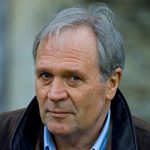Alan Cowell
Alan S. Cowell (1965, French and German) is a journalist, foreign correspondent and author.
During a career spanning over four decades, he lived abroad for 28 years in Switzerland, Germany (twice), Turkey, Zambia, Lebanon, Zimbabwe, Kenya, South Africa, Greece, Egypt, Italy and France. He worked mostly for Reuters and The New York Times.
“The languages I studied at The Hall were crucial in many ways. Speaking French and German enabled me to navigate lands and cities from Cold War Bonn to post-Wall Berlin, and from West Africa and Beirut to Paris and Geneva. The affinity for languages helped me acquire conversational Turkish, a smattering of essential Arabic and passable Italian. Most of all, the study of Gerard de Nerval among the 19th century French poets enabled me to weave a literary theme through my second novel, The Paris Correspondent.”
Cowell’s first book, in conjunction with the photographer David C. Turnley, was Why Are They Weeping – South Africans Under Apartheid. This was followed by Killing the Wizards, a memoir of a reporter’s life in Africa; A Walking Guide, his debut novel; The Terminal Spy covering the polonium poisoning of Alexander V. Litvinenko in London; and The Paris Correspondent chronicling the decline of print newspapers and the rise of the electronic media.
“After I graduated from Teddy Hall and finished up working on provincial evening newspapers, a close friend asked me why I was covering coroners’ courts and flower shows when I had a degree in French and German from Oxford,” Cowell said. “At the time I was working on The Cambridge News after my first job at The Lancashire Evening Post. My response was to apply for a job in Switzerland as a news writer and reader for The Swiss Broadcasting Corporation in Berne. And that was the start of a remarkable adventure in many lands that later figured prominently in my writing.”
Moving home every two or three years, Cowell covered stories including the Kurdish revolt in northern Iraq, the Lebanese civil war, the guerrilla campaign against white rule in Rhodesia, the collapse of apartheid in South Africa and an array of conflicts in Angola, Mozambique, Congo (then called Zaire), Chad, Somalia, Gaza, the West Bank, the Balkans, Iraq and elsewhere. From Rome he travelled widely with Pope John Paul II on papal journeys across the globe from Australia to Brazil. His coverage for The New York Times of the Litvinenko murder took him to Moscow where he interviewed the accused killers alleged by the British police to have poisoned the former K.G.B. officer with radioactive Polonium 210 planted in a teapot at a hotel in Grosvenor Square in November, 2006.
His first two novels drew closely on his experiences as a journalist in an era of great personal and professional change. The locations ranged from the white-owned farms of Robert Mugabe’s Zimbabwe to the English Lake District, which the Manchester-born Cowell has known since childhood. He has a particular font of experience to trace the parabola of change in the news business. In the late 1970s, covering the transition from Rhodesia to Zimbabwe, he became the last Reuters correspondent known to have sent his dispatches by carrier pigeon. Between 2008 and 2013 he oversaw the creation of a Paris-based online unit of The New York Times that focussed on breaking news in the internet era.
Those experiences also inspired a paper at the Reuters Society in 2017 considering the perils of fake news and Donald Trump’s campaign against the mainstream media.
A third novel, Permanent Removal, set in South Africa and exploring the web of relationships surrounding a particularly gruesome apartheid-era killing, was published in Johannesburg in April, 2016, drawing on Cowell’s first-hand experience as a foreign correspondent expelled by the P.W. Botha government in 1987. It is scheduled to be re-published in the United States in 2019.
Cowell’s fourth novel, Cat Flap, a feline fable that explores issues of identity, race and sexuality in 21st-century Britain, was published in 2018. In marked contrast to the far-flung settings of earlier novels, this closely woven urban parable unfolds on and and around Hampstead Heath.
In 2025, under his own imprint, UndatedBooks, Cowell published the third episode in a journalism trilogy centring around his protagonist Joe Shelby. The series began with “A Walking Guide” followed by “The Paris Correspondent.” The third book was called “Last Writes or The Obituarist” and centred on the quandaries of the AI era, taking Shelby from a tranquil life of ruminative semi-retirement on Hampstead Heath to an explosive climax in the Olympiastadion arena in Berlin.
